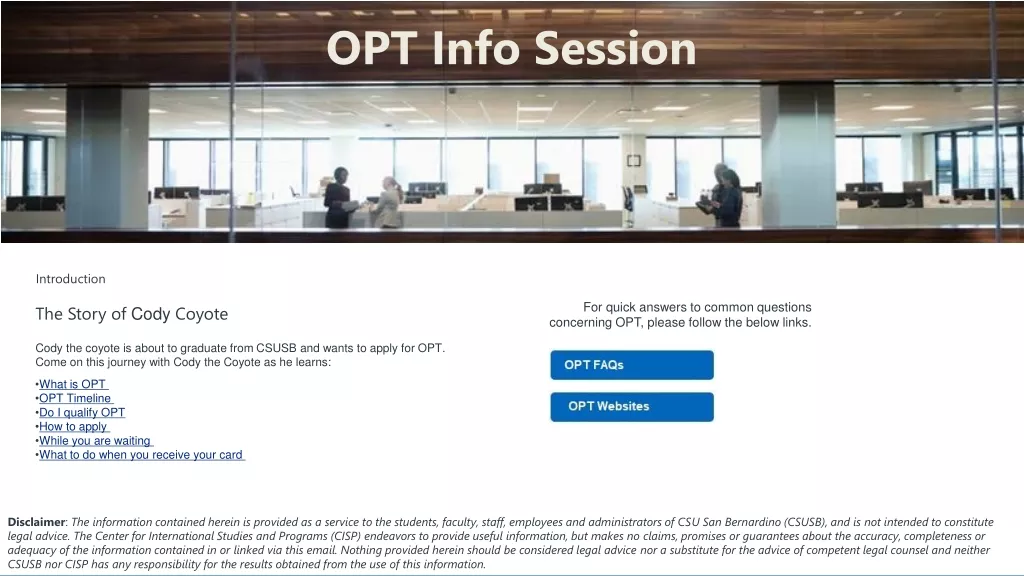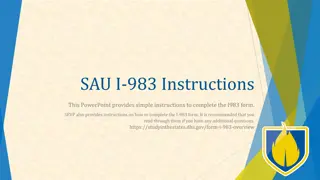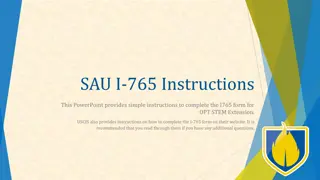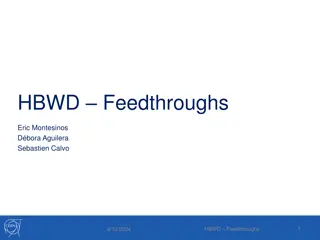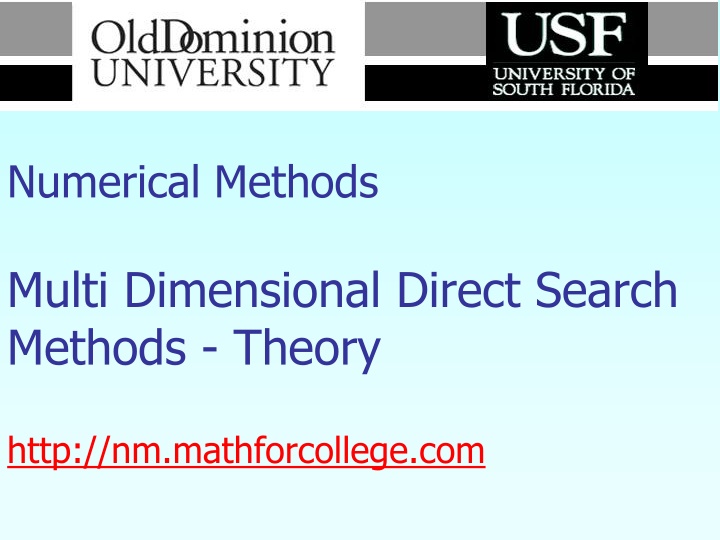
Multi-Dimensional Direct Search Methods Overview
Learn about multi-dimensional direct search methods, including concepts like coordinate cycling method and optimal point determination. Discover how these methods offer a non-differentiable approach to finding solutions. Visit the provided links for in-depth explanations and visual representations.
Download Presentation

Please find below an Image/Link to download the presentation.
The content on the website is provided AS IS for your information and personal use only. It may not be sold, licensed, or shared on other websites without obtaining consent from the author. If you encounter any issues during the download, it is possible that the publisher has removed the file from their server.
You are allowed to download the files provided on this website for personal or commercial use, subject to the condition that they are used lawfully. All files are the property of their respective owners.
The content on the website is provided AS IS for your information and personal use only. It may not be sold, licensed, or shared on other websites without obtaining consent from the author.
E N D
Presentation Transcript
Numerical Methods Multi Dimensional Direct Search Methods - Theory http://nm.mathforcollege.com
For more details on this topic Go to http://nm.mathforcollege.com Click on Keyword Click on Multi Dimensional Direct Search Methods
You are free to Share to copy, distribute, display and perform the work to Remix to make derivative works
Under the following conditions Attribution You must attribute the work in the manner specified by the author or licensor (but not in any way that suggests that they endorse you or your use of the work). Noncommercial You may not use this work for commercial purposes. Share Alike If you alter, transform, or build upon this work, you may distribute the resulting work only under the same or similar license to this one.
Multi Dimensional Direct Search Methods Method-Overview Obvious approach is to enumerate all possible solutions and find the min or the max. Very generally applicable but ccomputationally complex. Direct search methods are open. A good initial estimate of the solution is required. The objective function need not be differentiable. 5 http://nm.mathforcollege.com
Coordinate Cycling Method Starts from an initial point and looks for an optimal solution along each coordinate direction iteratively. For a function with two independent variables x and y, starting at an initial point (x0,y0), the first iteration will first move along direction (1, 0) until an optimal solution is found for the function . The next search involves searching along the direction (0,1) to determine the optimal value for the function. Once searches in all directions are completed, the process is repeated in the next iteration and iterations continue until convergence occurs. The search along each coordinate direction can be conducted using anyone of the one-dimensional search techniques previously covered. 6 http://nm.mathforcollege.com
Multi Dimensional Direct Search Optimal point Point after second cycle Point after third cycle Point after Initial search point first cycle length Figure 1: Visual Representation of a Multidimensional Search 7 http://nm.mathforcollege.com
THE END http://nm.mathforcollege.com
Acknowledgement This instructional power point brought to you by Numerical Methods for STEM undergraduate http://nm.mathforcollege.com Committed to bringing numerical methods to the undergraduate
For instructional videos on other topics, go to http://nm.mathforcollege.com This material is based upon work supported by the National Science Foundation under Grant # 0717624. Any opinions, findings, and conclusions or recommendations expressed in this material are those of the author(s) and do not necessarily reflect the views of the National Science Foundation.
Numerical Methods Multi Dimensional Direct Search Methods - Example http://nm.mathforcollege.com
For more details on this topic Go to http://nm.mathforcollege.com Click on Keyword Click on Multi Dimensional Direct Search Methods
You are free to Share to copy, distribute, display and perform the work to Remix to make derivative works
Under the following conditions Attribution You must attribute the work in the manner specified by the author or licensor (but not in any way that suggests that they endorse you or your use of the work). Noncommercial You may not use this work for commercial purposes. Share Alike If you alter, transform, or build upon this work, you may distribute the resulting work only under the same or similar license to this one.
Example . l l b The cross-sectional area A of a gutter with base length b and edge length of l is given by 1 b b A + + = ( 2 cos ) sin l l 2 Assuming that the width of material to be bent into the gutter shape is , find the angle and edge length which maximizes the cross-sectional area of the gutter. Notes : To get the maximum cross-sectional area 0 = b+ 6 ( 6 2 ) l l . 1 5708 2 max To have a physical meaning, (otherwise b will have a negative value!) 3 l 16 http://nm.mathforcollege.com
Solution Recognizing that the base length b can be expressed as , we can re-write the area function as l b 2 6 = = + , ( l f ) 6 ( 2 cos ) sin l l l Use as the initial estimate of the solution and use Golden Search method to determine optimal solution in each dimension. = , 0 ( . 0 5236 ) 6 To use the golden search method we will use as the lower and upper bounds for the search region = 0 3 l 17 http://nm.mathforcollege.com
Solution Cont. Iteration 1 along (1,0) . 0 , ( l f = 6 [ = + 5236 ) 2 5236 . 0 cos( )] 5236 . 0 sin( ) rad l l l Iteration xl xu x1 x2 f(x1) 3.6143 3.8985 3.9655 3.9654 3.9655 3.9692 3.9692 3.9692 3.9694 3.9694 f(x2) 2.6941 3.6143 3.8985 3.9655 3.9497 3.9655 3.9692 3.9683 3.9692 3.9694 1 2 3 4 5 6 7 8 9 0.0000 1.1459 1.8541 2.2918 2.2918 2.4590 2.5623 2.5623 2.6018 2.6262 3.0000 3.0000 3.0000 3.0000 2.7295 2.7295 2.7295 2.6656 2.6656 2.6656 1.8541 2.2918 2.5623 2.7295 2.5623 2.6262 2.6656 2.6262 2.6412 2.6506 1.1459 1.8541 2.2918 2.5623 2.4590 2.5623 2.6262 2.6018 2.6262 2.6412 3.0000 1.8541 1.1459 0.7082 0.4377 0.2705 0.1672 0.1033 0.0639 0.0395 10 . 2 ( 6459 . 0 , 5236 ) The maximum area of 3.6964 is obtained at point by using either Golden Section Method (see above table) or analytical method (set ). 0 = l dl df = . 2 6459 18 http://nm.mathforcollege.com
Solution Cont. Iteration 1 along (0,1) 6459 . 2 = , 6 [ = 6459 . 2 6459 . 2 + 6459 . 2 ( ) 2 cos ] sin f l Iteration xl xu x1 x2 f(x1) 4.8084 4.1088 4.8084 4.8689 4.8816 4.8672 4.8816 4.8820 4.8826 f(x2) 4.3215 4.8084 4.8689 4.7533 4.8689 4.8816 4.8820 4.8790 4.8820 1 2 3 4 5 6 7 8 9 0.0000 0.6002 0.6002 0.6002 0.7419 0.8295 0.8295 0.8295 0.8502 1.5714= 1.5714 1.2005 0.9712 0.9712 0.9712 0.9171 0.8836 0.8836 0.9712 1.2005 0.9712 0.8295 0.8836 0.9171 0.8836 0.8630 0.8708 0.6002 0.9712 0.8295 0.7419 0.8295 0.8836 0.8630 0.8502 0.8630 1.5714 0.9712 0.6002 0.3710 0.2293 0.1417 0.0876 0.0541 0.0334 2 . 2 ( 6459 . 0 , 87 ) The maximum area of 4.8823 is obtained at point ,by using either Golden Section Method (see above table) or analytical method (set ). 87 . 0 0 = = d df 19 http://nm.mathforcollege.com
Solution Cont. Since this is a two-dimensional search problem, the two searches along the two dimensions completes the first iteration. In the next iteration we return to the first dimension for which we conducted a search and start the second iteration with a search along this dimension. After the fifth cycle, the optimal solution of (2.0016, 1.0420) with an area of 5.1960 is obtained. The optimal solution to the problem is exactly 60 degrees which is 1.0472 radians and an edge and base length of 2 inches. The area of the gutter at this point is 5.1962. 20 http://nm.mathforcollege.com
THE END http://nm.mathforcollege.com
Acknowledgement This instructional power point brought to you by Numerical Methods for STEM undergraduate http://nm.mathforcollege.com Committed to bringing numerical methods to the undergraduate
For instructional videos on other topics, go to http://nm.mathforcollege.com This material is based upon work supported by the National Science Foundation under Grant # 0717624. Any opinions, findings, and conclusions or recommendations expressed in this material are those of the author(s) and do not necessarily reflect the views of the National Science Foundation.



